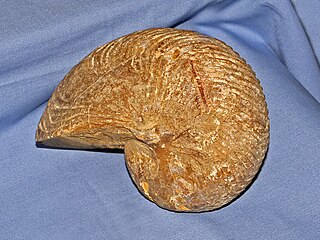Related Research Articles
Tarphyeras is a genus of tarphyceratid with whorls rounded in cross section, having a deeply impressed dorsum and a ventral to subcentral siphuncle, known from the Lower Ord of North America. It differs from Campbelloceras in that Campbelloceras is only slightly impressed, from Centrotarphyceras in that Centrotarphyceras is subquadrate and has a central siphuncle, and from Trocholites in that although Trocholites is subcircular in cross section, the siphuncle is subdorsal.
Jovellania is a genus of extinct prehistoric nautiloids from the order Oncocerida known from the Lower Devonian of Europe. Nautiloids form a broad group of shelled cephalopods that were once diverse and numerous but are now represented by only a handful of species in two genera.
Acleistoceras is a genus of the oncocerid, nautiloid family Acleistoceratidae that lived in the shallow seas that covered much of North America during the Devonian; living from 409—383.7 mya, existing for approximately 25.3 million years.

The Trigonoceratoidea are a superfamily within the Nautilida that ranged from the Devonian to the Triassic, thought to have contained the source for the Nautilaceae in which Nautilus is found.
Jovellaniidae was established as a family within the Oncocerida to include genera characterized by longiconic orthocones and cyrtocones with a subtriangular to depressed cross-section in which the ventral (siphuncular) side is typically angular or more acutely rounded than the dorsal (antisiphuncular) side, and in which the siphuncle is generally large, ventral, and with lamellar actinosiphonate deposits
The Graciloceratidae is a family of nautiloid cephalopods from the Middle and Upper Ordovician belonging to the Oncocerida, characterized by exogastric cyrtocones that expand slightly or moderately and have thin walled, orthochoantic marginal or subventral, tubular siphuncles.
The Bassleroceratidae is a family of gradually expanding, smooth ellesmerocerids with a slight to moderate exogastric curvature, subcircular to strongly compressed cross section, and ventral orthochaonitc siphuncle. The ventral side is typically more sharply rounded than the dorsal side and septa are close spaced. Connecting rings are thick and slightly expanded into the siphuncle, making the segments slightly concave; characteristic of the Ellesmerocerida.
The Tripteroceratidae is a family of depressed, straight to slightly curved nautiloid cephalopods from the middle and upper Ordovician with generally flattened venters and empty siphuncles with straight to inflated sedments included in the Oncocerida.

The Cymatoceratidae is a family of Mesozoic and early Cenozoic nautiloid cephalopods and the most abundant of this kind in the Cretaceous. They are characterized by ribbed, generally involute shells of varied form - coiled such that the outer whorl envelops the previous, as with Nautilus, and sutures that are variably sinuous.
Mandaloceratidae is a family in the nautiloid cephalopod order Discosorida, from the Middle and Upper(?) Silurian characterized by short, essentially straight shells referred to as breviconic, typically with a faintly exogastric shape produced by the profile of the body chamber. Apertures vary from round to T-shaped, with a long narrow, ventral, hyponomic sinus for the maneuvering funnel. Siphuncles are commonly central or subcentral with generally broad, expanded, segments and usually thin connecting rings.
Aphelaeceras is an extinct genus from the nautilid family Trigonoceratidae which is part of the Trigonocerataceae, that lived during the Mississippian Period in the late Paleozoic.
Rineceras is an extinct genus from the nautilid family Trigonoceratidae which is part of the Trigonocerataceae, that lived during the Mississippian Period in the late Paleozoic.
Liroceras is a genus of nautiloid cephalopod. It is the type genus of the clydonautiliacean family, Liroceratidae, and is characterized by a rapidly expanding, subglobular, nautiliconic shell with a reniform whorl section, small umbilicus, essentially straight sutures, and a siphuncle with a variable but not marginal position.

Trochoceras is a genus of trochoidally coiled nautiloid cephalopods placed in the nautilid family Rutoceratidae that lived during the Middle and Late Devonian in what is now central Europe.
Ophioceras is a genus of closely coiled tarphycerid nautiloid cephalopods, the sole representatives of the family Ophidioceratidae, characterized by an evolute shell with narrow, subrounded, annulated whorls and a subcentral siphuncle composed of thin connecting rings that show no evidence of layering. The mature body chamber is strongly divergent and is the longest proportionally of any tarphycerid. The aperture has a deep hyponomic sinus and ocular sinuses, and so resembles some lituitids.
Allocotoceras is an endocerid from the Lower Ordovician of Australia (Tasmania), included in the Endoceratidae, based on small, straight or gently curved siphuncles.
Augustoceras is a genus of nautiloid cephalopods included in the order Oncocerida and family Valcouroceratidae. It is known form the Middle and Upper Ordovician of Kentucky and Ohio in the US.

Geisonoceras is an extinct orthocerid genus named by Hyatt, 1884, and type for the Geisonoceratidae established by Zhuravleva in 1959.
Kiaeroceras is a slender, nearly stright shelled, cyrogomphoceratid (Nautiloidea-Discosorida) from the Upper Ordovician of northern Europe. The cross section of the shell is compressed, height greater than width. The body chamber is slightly contracted so as to narrow toward the aperture, which in some is slightly flared. The venter, narrowly rounded. The siphuncle is close to the venter, septal necks short, connecting rings thick, bullettes prominent.
Librovitschiceras is a genus of nautilids, in the subclass Nautiloidea, with a triangular cross section, included in the family Aipoceratidae. Its exact relationship with other aipoceratids is uncertain. Whorls are in contact, the siphuncle is slightly removed from the venter, which has a deep sinus.
References
- Walter A Sweet, 1964. Nautiloidea - Orthocerida, Treatise on Invertebrate Paleontology, Part K, incl Nautiloidea. Geological Society of America and University of Kansas Press.
| This prehistoric nautiloid-related article is a stub. You can help Wikipedia by expanding it. |